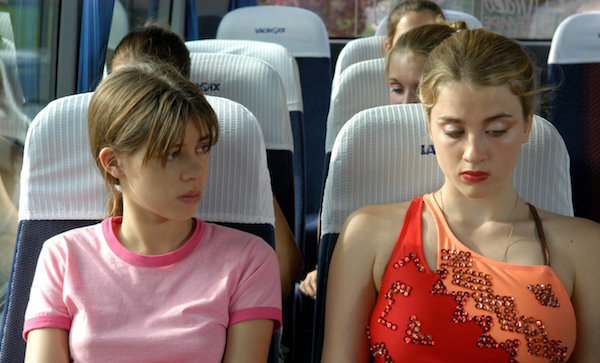Before Portrait of a Lady on Fire, there was Water Lilies. Evoking the plasticised sensation of the erotic first established by Audre Lorde, Céline Sciamma’s film unpacks the mechanics of femininity in gendered violence through leisure and sport. Rose Higham-Stainton dives deeper to explore the film’s nuances.
Girls beat the water, churning it up, are propelled into the air, and plunge beneath the surface. Thrust, twirl, split. Thrust, twirl split. Crane, Eggbeater, Descending Spin.
To synchronise is to happen at the same time, or to do what the other person, or people, or cog or wheel, is doing. In Water Lilies, Céline Sciamma’s 2007 debut feature, synchronisation speaks to the mechanics of femininity and the filmmaker employs the high-shine world of synchronised swimming as context, aesthetic and form.
The film considers femininity as both product and mode of production, through this prism of precision and surfaces and hierarchies. A triptych of female characters explore the paradox of camaraderie and rivalry among young women, both in friendship and in competitive sports, while an aesthetic of artifice and slickness, in tight-licked hair, glossed mouths, and lycra-clad bodies summons what Audre Lorde calls the “plasticised sensation” of the erotic in mainstream culture. Sometimes that plasticised sensation gets turned into labour. Here, poker-straight postures and drill-legs and poolside line-ups are conveyor belts and factory lines of femininity, at the heart of which are these bodies. We watch them perform from the bleachers, mouths gasping for air in constant states of submersion and emersion, and bound up in this paradox of visibility and invisibility. I am reminded of Rebecca Solnit in Recollections of My Non-Existence when the writer says femininity is “a perpetual disappearing act, an erasure and a silencing to make more room for men, one in which your existence is considered an aggression and your nonexistence a form of gracious compliance.”
Set amongst the architectural right angles of suburban Paris, Water Lilies is a convoluted game of cat and mouse. It centres on the slight, awkward, near-mute 15-year old Marie (Pauline Acquart) and her sexual awakening with Floriane (Portrait’s Adele Haenel), the beautiful dead-eyed swim team captain. Marie pursues Floriane by trying to join the team. But Floriane has her sights set on Francois, the school jock. Marie’s best friend Anne (Louise Blachere) — also awkward, but in a way that is too much or kind of extra — is in pursuit of Francois too. By the end of the film, Marie gets her moment with Floriane and Anne gets Francois, as well as revenge on him for his abuse of her feelings — she lingers for a kiss before spitting in his mouth.
On the surface, the film is about sexual identity and formative sexual relationships. But there are subtexts too — frames within frames — that ripple out. Namely, the construction of femininity: how we define it, who makes it and how we break free. Femininity becomes a form of labour, and laboured over, in synchronised swimming. if we come to understand femininity as grace, allure, beauty, elegance, a softness and appeasement, constructed by and for men, then Sciamma seeks to denounce it — unfeasible, stunted, illegitimate, one-dimensional, limiting and limited — like a broken machine. And she does it from the inside out.
The film opens in the clamorous confines of a tiled, neon-lit locker room; camera weaving between girls rehearsing routines — “quatre, cinq, six, sept” they chime — and applying each other’s make-up, fixing hair. Flesh in stretched pink sparkle costumes, under fluorescent light, summons the sensory and the ornamental as the ultimate bind of femininity. It is solidified in a poolside line-up of unidentifiable bodies, doubled in surface reflections and backed by a transparent pane of sunset-saccharine violets and pinks in wave formation. The film is stained in artificial tones that contort and contain the image, in monstrous shades of vomit green (in bathroom stalls), violent red lights (on dance floors), and in the toxic blue of masculinity at a swim party where shirtless teenage boys violently clash their bodies wearing pants as balaclavas. Gendered violence masquerades as leisure and sport in Water Lilies. We see it in the cattle-like line-ups of poised torsos dressed in glitter, and in the violent scrutiny of the coach as she checks for visible pubic hair and hands out razors. The girls suck their breath like sacrificial lambs sent to slaughter. Solnit wrote “The problem isn't really with bodies, but with the relentless scrutiny to which they’re subjected. The problem is being a woman.”’
Amidst the desperate perfection of the pool, Marie and Anne are the unregulated and ill-fitting parts. Marie deals with it by trying to disappear—recoiling into every corner and crevice of the screen, reluctant to undress in locker rooms and bedrooms—until, that is, she wants Floriane’s attention. Conversely, Anne, the sidelined best friend, desperately wants to appear, to be noticed, bounding on trampolines, dancing wildly. They embody a failed femininity — too much and not enough in their physicality, their temperament. This compounded failure causes their friendship to fracture. “I’m fed up of you. You're a burden,” Marie says to Anne. But they still find their way back to one another. In Marie’s acknowledgement of her feelings for Floriane, and the renouncement of her straightness, and in Anne’s renouncement of the jock, they also renounce the confines of toxic femininity — dependent on learnt feminine traits – physical, behavioural — as a mechanism of patriarchal control. And we discover that Floriane, too, refuses the terms of femininity that she appeared on the surface to fulfil. Neither femme fatale nor ingenue, her dead eyes and mechanical smile allow her to drift through the spaces — the locker room and dance floor — like a broken doll, removed or apart.
The textural slickness, in wetness and glitter and gloss, that pervades Water Lilies is a double entendre. It stands for both the precision of competitive sport, and femininity, as well as a kind of sensual awakening. Because to be wet is to be sexually aroused, and the film’s French title, Naissance des Pieuvres or "birth of the octopuses”, is a visceral, fecund image. In Lorde’s Uses of the Erotic, the writer talks about the erotic in mainstream culture and in pornography as a kind of deadening of women’s bodies (not to mention actual violence against those bodies). She says, “On the one hand, the superficially erotic has been encouraged as a sign of female inferiority; on the other hand, women have been made to suffer and to feel both contemptible and suspect by virtue of its existence.”
In the wet-look, gelatin-slicked hair, synthetic glitter and glistening lycra, skin plasticised by chlorinated water, these girls, like surprised dolls, veer uncomfortably close to the superficially erotic. But this slippery texture in Water Lilies perhaps also offers a way out — not cinematic perfection but an aesthetic of spit, shine, gloss that veers on the grotesque, distorted body in frames and screens and boundaries — eventually broken and moved through. From sensation to feeling.
Cinematographer Crystel Fournier articulates the containment of gender in lingering close-ups. On Marie’s fumbling feet, or trembling lips, in tight frames of cranking limbs in water. It also moves in unapologetic cuts and long tracking shots heightened by the sharp angles of suburban Paris, of modern housing, of sports complexes with narrow corridors and subterranean car-parks. Marie, our anti-heroine, reminds us of these limits in a lucid observation: “The ceiling is probably the last thing people see before they die...Imagine all those people with ceiling in their eyes.” And it is Marie, amid the grander expanses of a liquid mass and concrete and straight lines, who breaks those confines. Later, she and Floriane walk out across the great concrete plain of an industrial power station towards the horizon.
Within these cinematic frames, Sciamma summons the mechanics of the body and its regulation; in the rigorous symmetry of synchronised swimming, in cycling legs and spiralling torsos, that assume the look of cogs and drills churning and penetrating the water. When Marie finally enters the water, she watches the swimmers perform for the bleacher’s crowds from under the surface, their convulsing bodies muted but restless, pulsing. It is the backstage of femininity — the reality of bodies, the messy, beating heart magnified by rushing water, the pounding noises, voices against hard surfaces and a score from Jean-Baptiste de Laubier (as Para One), interspersing melodramatic, operatic competition music, loaded with notions of love and lust – which syncs up with Marie’s personal narrative.
Water Lilies, like Portrait of a Lady on Fire, foregrounds (albeit in another place and time) a girl’s journey to sexual enlightenment and the flux and fervour of desire that takes on religious heights in redemptive water and blazing fire. For Marie, it manifests in a climactic baptism, when she plunges into the pool in all her clothes. Anne follows suit, and they float on the surface, hand-in-hand. The film is an awakening, a refusal, of the dissolution of the self, and a return to one another. Solidarity in all its forms.
Buy our CÉLINE SCIAMMA t-shirt
Rose Higham-Stainton writes creative nonfiction, criticism and prose that explores representations of femininity, modes of resistance and the body in women’s creative practice. Her writing is held in the Women’s Art Library at Goldsmiths College and has appeared in publications including PIN-UP Magazine, MAP Magazine, NOIT, Dazed Digital, LOVE and V Magazine. She recently completed a Masters in Writing at the Royal College of Art, where she focused on femininity through the prism of myth, drawing on art and literary criticism, cultural theory and autobiography.





